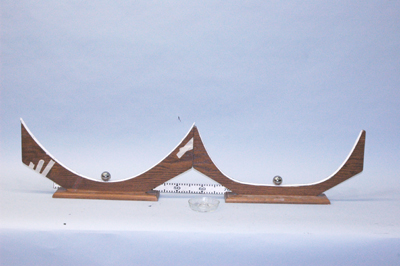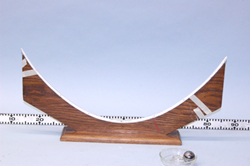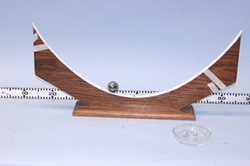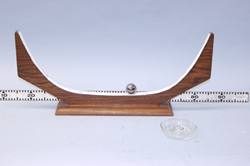Ball on "U" Tracks, 3A40.22
Topic and Concept:
Oscillations, A40. Simple Harmonic Motion
Location:
Cabinet: Mechanic (ME)
Bay: (A4)
Shelf: T

Abstract:
A ball is rolled on a symmetric "U" shaped track to show harmonic motion and compared to a symmetric elongated "U" shape track to show non-harmonic motion.
Equipment |
Location |
ID Number |
|
|
|
U Tracks |
|
|
1.5" Ball Bearings |
ME, Bay B13, Shelf #3 |
|
Important Setup Notes:
- N/A
Setup and Procedure:
- Place the two tracks side by side on a table so that the broad sides face the audience.
- Hold the ball bearing on the U-shaped track (curved bottom) and slide it up along the track until it is about an inch from the end.
- When ready release the bearing and note the frequency of oscillations stays constant while the amplitude decays.
- Repeat step 2 with the elongated U-shaped track (flat bottom).
- Now release the bearing. This time notice, that the amplitude has a quick decrease and then slowly decays. Meanwhile, the frequency of oscillation changes.
Cautions, Warnings, or Safety Concerns:
- N/A
Discussion:
For each track, we see oscillatory motion: the ball bearing is displaced from equilibrium, returns to equilibrium, passes this point to reach another maximal displacement and repeats the process. By definition, harmonic motion is oscillatory motion that can be described with a single frequency. It occurs in systems where the total restoring force is proportional to the displacement from equilibrium. In our case, there is significant friction so that each oscillator is damped. Thus, on both tracks, the amplitude of oscillation (maximal displacement from equilibrium) decays with time. The regular U-shaped track system has a restoring force proportional to the displacement due to gravity. This is why we see harmonic motion on this track. The elongated U-shaped track is missing the restoring force (when flat, there is no component of gravity along the track) for a significant portion of the bearing's motion. This is why the frequency of oscillation changes as the amplitude decays.
|
|
|
|
|
Videos:
References:




